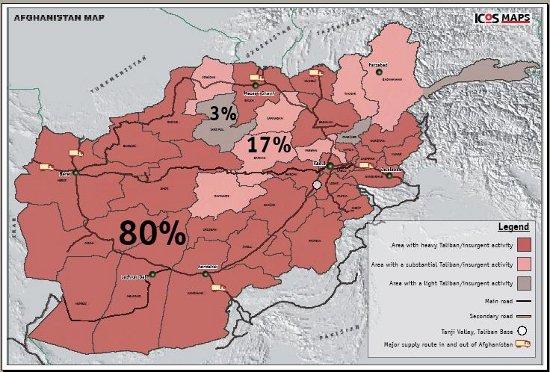ICOS rating on Taliban control in Afghanistan is meaningless

|
| The ICOS' meaningless map on Taliban presence in Afghanistan. |
The latest report by the The International Council on Security and Development on the security situation in Afghanistan is making plenty of waves. According to the report, 97 percent of Afghansitan is infested with the Taliban.
The Taliban now have a permanent presence in 80% of Afghanistan, up from 72% in November 2008, according to a new map released today by the International Council on Security and Development (ICOS). According to ICOS, another 17% of Afghanistan is seeing ‘substantial’ Taliban activity. Taken together, these figures show that the Taliban has a significant presence in virtually all of Afghanistan.
But when you look a little more closely at how the ICOS determines if a province has a permanent or significant Taliban presence, the standards are so low as to be almost meaningless:
Permanent presence: defined by provinces that average one (or more) insurgent attack (lethal and non-lethal) per week.Substantial presence: an average one or more insurgent attacks per month and include residents who believe Taliban are active locally (based on frequency of Taliban sightings).
Light presence: defined by less than one insurgent attack per month and local residents don’t believe Taliban is active locally (based on frequency of Taliban sightings). To calculate percentages, the total area of Afghanistan was divided by the total area hosting a permanent/substantial/light Taliban presence.
There is little doubt that the security situation in Afghanistan is in decline. But the ICOS' ratings tell us little about the security problems that exist in Afghanistan.
If you want to know about the level of Taliban presence, it makes more sense to break out the country by districts. And you need to look at more than just attacks and sightings. Are the Taliban collecting taxes, running a parallel government, openly recruiting fighters? Are local security forces providing security or are they holed up in district centers? Does the Taliban run the region from dusk until dawn? Do schools remain closed due to Taliban threats? Were the people in the district able to vote in the last election? Etc.
